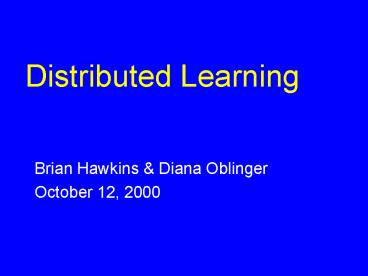Distributed Learning - PowerPoint PPT Presentation
1 / 31
Title:
Distributed Learning
Description:
Consider a few facts.... The US currently spends $740 billion per year on ... more than the GDPs of Spain, Canada or Brazil. Moe, 1999. Consider a few facts... – PowerPoint PPT presentation
Number of Views:45
Avg rating:3.0/5.0
Title: Distributed Learning
1
Distributed Learning
Brian Hawkins Diana Oblinger October 12, 2000
2
Consider a few facts.
- The US currently spends 740 billion per year on
education... - ... more than is spent on national defense
- more than the GDPs of Spain, Canada or Brazil
- Moe, 1999
3
Consider a few facts.
- Distance education is expected to grow at a
compound annual growth rate of 33 (IDC) - Demand for distance education will grow to 15 of
all students by 2002 - The e-learning market is expected to reach 46
billion by 2005
4
Consider a few facts.
- Over 5,000 competitors offer all types of
e-learning no single competitor has more than a
5 market share - Last year, over 100 e-learning portals entered
the market - Partnerships between non-traditional providers
and universities are increasing
5
Distributed Learning
- Thinking about whether
- and/or
- how to enter this area
- www.northcarolina.edu/educause/de/
6
Hype or Reality?
- How large is this market?
- What will be the impact on residential education?
- What role should my campus play?
7
Concerns to be Examined
- Definition of distributed learning
- Realistic estimates of the market
- Institutional motivations
- Assumptions
- Matrix of responsibilities
- Institutional readiness
8
Definitions
- Distributed learning is the delivery of
education via electronic media, including
intranets, extranets, satellite broadcast, etc.
It uses technology to deliver learning that is
independent of time and place.
9
The Marketplace
- Higher education is not a single marketplace.
- It is a host of markets and distributed learning
adds even more market segments.
10
Traditional Students
- 18-22 year olds
- 16 million students
11
New Traditional Students
- 18-22 year olds
- 4 million more
- Many campuses are out of space
- Might need 130 new campuses
- New campus costs
- 350 M to build
- 323 M to operate
- Is this a realistic solution?
12
Adult Learners in the US
- 28 million
- Workforce should spend 20 of time engaged in
learning - Equivalent to 30 credits every 7 years
- Do we have the space?
- Will they even come to campus?
13
International Learners
- Possibly 100 million
- Results in potentially huge market
14
How Realistic are the Projections for US
Providers?
- What effect do the following have on the size and
complexity of the market? - Language
- Culture
- Cost
- Connectivity
15
Other Potential Market-Limiting Factors
- Ability to pay
- Willingness to pay
- Role of accreditation
- Transferrability
16
Who is the Competition?
17
Focused Market Players
- Professional Advancement
- Business Health
Teacher training - Apollo, DeVry, ITT
18
Higher Ed Consortia
- Shared risk
- Leverage
- WGU, KVU
- Unext
19
Remediation Enrichment
- K-12 arena?
- Charter role
- Sylvan
- Alumni
- Community
20
Corporate Training
- Mass scale
- Internal conflicts
- Provant, Ziff
21
Individual Campus Strategy
- Viability?
- Leverage?
- Infrastructure cost?
- Marketing cost?
22
Institutional Motivations
- To increase access to education and to serve the
public good - To increase capacity
- To improve teaching and learning
- To make money
23
Assumptions
- The course is the unit of measure for learning
- Traditional institutional models will be
successful - Quality from for-profit providers is inferior
- Distributed learning is a viable option for all
institutions
24
Topics
- Rationale/Need for DE
- Definition
- Market
- Academic Issues
- Technical Issues
- Support/Services
- Organization
- Policies
- Financing
- Institutional Self-Assessment
25
Technical Issues
- Hardware/software
- Network
- Support
- Course management systems
- Content conversion
- Security
26
Academic Issues
- Articulation
- Program selection
- Student readiness
- Quality
- Residency
- Workload
- Rewards
27
Policies
- Intellectual property
- Conflict of interest
- Conflict of commitment
- Accessibility
- Appropriate use
- Privacy
28
Support Structures
- Application
- Registration
- Counseling
- Library
- Career services
29
Integration
- Does your distributed learning plan integrate
with - institutional plan
- academic plan
- financial plan
- technology plan?
- Can your campus effectively collaborate?
30
Risk
- Is your campus prepared for the risk
- external forces
- internal forces
- market risk
- economic risk
31
Summary
- Is distributed learning right for us? Today? In
the future? - Have we analyzed the market correctly?
- How do we divide the responsibilities to ensure
success? - Are we ready to move forward?































